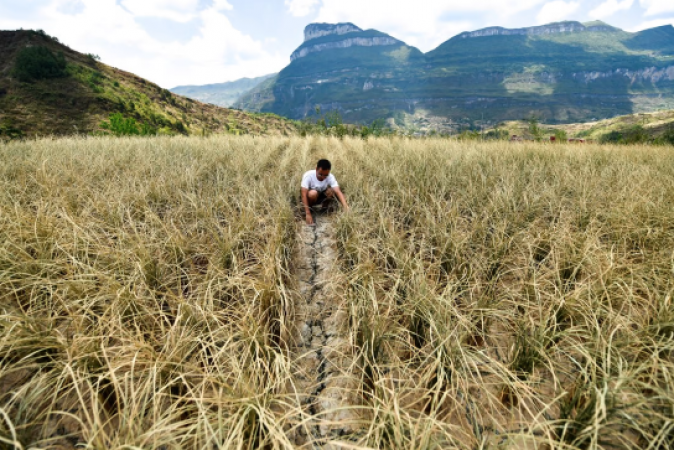
BEIJING: Zhang Yu and her husband depend on the health of China's largest lake for their livelihood, just like generations before them. On the shores of Lake Poyang, the couple typically earn about 60,000 yuan (US$8,700) a year for rice, corn and sesame cultivation, which is barely enough to support a family of six.
However, their incomes are likely to be cut in half this year as more than 20 provinces across the country are hit by record-breaking heat and drought.
Jiangxi Province, one of China's rice-growing regions, relies heavily on irrigation from Poyang Lake and the surrounding wetlands.
Although the size of the lake varies with wet and dry seasons each year, it is generally becoming smaller. However, as southern China has not received any rain since July, the water level has fallen at the fastest rate ever, reaching a low of eight meters in early September.
The lake's water area was 3,331 square meters (35,854 sq ft) in size at the end of June, but by last week it had reduced to just 727 square meters.
I've never seen such a drought, Zhang said. Nearby ponds and reservoirs have dried up.
Farmers and governments are on edge because of extreme weather, which scientists predict will happen more often as a result of climate change.
China produces three quarters of its grain during the autumn harvest. While the first of China's three rice crops were successfully harvested under normal conditions, the second crop, or "middle rice", is currently entering the flowering stage, and the third crop, or late crop, is under development. . is in phase.
Both respond strongly to changes in temperature and precipitation.
Zhang, whose farm is in one of the most desolate areas of his village, is becoming more concerned about the summer and autumn harvest.
Their village lacks water in rice fields, corn fields, fish and shrimp fields and rice paddies. Due to the scorching heat, there has also been an outbreak of rare insects.
According to Zhang, we can only rely on the morning dew as it hasn't rained since July.
Pesticides are ineffective due to extreme heat, and the pest problem is particularly bad.
According to the China Meteorological Agency, although the heat wave has subsided somewhat, the drought has not stopped and may well last into the fall.
Along with other provinces in the middle and lowlands of the Yangtze River basin such as Hunan and Anhui, Jiangxi's grain production is most at risk. But other provinces such as Sichuan, Hubei, Henan and Guizhou have also been affected.
According to Li Ge, a farmer in Yugan County in northern Jiangxi, the drought will undoubtedly affect rice production, but the full extent will not be known until late September.
The farmer, who was in his late 50s, said, "It costs us a lot of extra money to fight the drought. Additionally, he said the cost of fertilizer rose from 115 yuan to 200 yuan this year Is.
In previous years, Li made between 400 and 500 yuan per mu (0.66 ha), but this year, he predicted it might only be 200 yuan.
A city-level agriculture official in Nanchang city said that despite relevant indicators, it is still too early to predict rice yield for the upcoming crop. He declined to be named as he did not have the right to speak to the media.
"We don't know whether it can reach the end of September," he said, "because if it doesn't rain, the water level in nearby rivers and reservoirs will continue to drop."
Now everyone in the village, from the cadets to the farmers, has one mission: to end the drought.
His city has invested heavily in bringing water from rivers to fields and is constantly monitoring the state of irrigation.
I haven't slept through the night since July, she admitted.
According to Fitch Ratings last week, prices are unlikely to fluctuate significantly due to a possible reduction in China's rice production this year as a result of unfavorable weather in the Yangtze River region.
The seven worst-affected provinces, where Fitch predicts a 10-20% loss rate for mid-season rice this year, "are expected to reduce China's annual rice production by 3-6%, or 7 million-14 million metric tons." is likely to." can,” it said.
"China's import needs may increase due to lower domestic yields, but the country's large rice reserves and the government's willingness to tolerate minor fluctuations in reserve levels should keep them under control."
Despite the extreme weather this year, Li Guoxiang, a researcher at the Institute for Rural Development of the Chinese Academy of Social Sciences, claimed that China is in a good position to protect food production and stabilize prices.
He claimed that due to China's recent expansion of farmland for grain production, domestic rice production had increased and there was currently a surplus.
According to him, China has converted 900 million mu, or roughly half of the country's total arable land, into "high-standard" farmland.
On this farmland, which has been improved to better withstand extreme weather, industrial farming and effective irrigation are being used to save water and boost crop yields.
"The food crisis in China is a structural problem. The current drought has a limited impact on domestic food security or the overall price of food because it is primarily a shortage of feed grain with a surplus of rice, Li said.
But Zhang, who is anticipating a sharp decline in income this year, will find little solace in that. Her children's medical expenses, the rent on the farmland she rents, and the fertiliser for the spring planting of the following year are all expenses.
Later this year, I'll undoubtedly need to borrow money from family members. Many of the local households are struggling,"
China and Nepal sign a BRI six-point agreement
US violence and deteriorating bilateral relations thwart Chinese tourists
Chinese leader Xi Jinping gets ready for a crucial meeting with Vladimir Putin